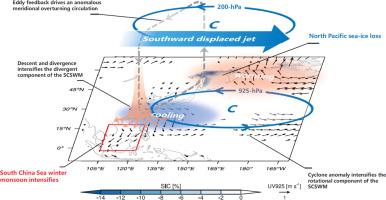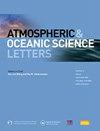A non-ENSO driver of the South China Sea winter monsoon: North Pacific sea ice
IF 3.2
4区 地球科学
Q3 METEOROLOGY & ATMOSPHERIC SCIENCES
引用次数: 0
Abstract
The South China Sea winter monsoon (SCSWM), an integral component of the East Asian winter monsoon, connects extratropical and tropical regions. Utilizing ERA5 reanalysis and PAMIP simulations, the relationship between Arctic sea ice and the SCSWM is investigated. The authors reveal that its strongest relationship with Arctic sea ice occurs in the North Pacific sector, i.e., the Sea of Okhotsk and western Bering Sea. This link persists throughout the cold season, peaks when sea ice precedes the SCSWM by one month, and is independent of ENSO. North Pacific sea-ice loss weakens the meridional temperature gradient (MTG) and vertical wind shear in midlatitudes, reducing baroclinic eddy formation. Given the reduced zonal wind according to the thermal wind relation, the reduced wave activity flux in the upper troposphere must be balanced by equatorward wind based on the quasi-geostrophic momentum equation. This generates an anomalous meridional overturning circulation with descent and low-level divergence around 30°N, which intensifies the divergent component of the SCSWM. The divergent northerly anomalies also lead to cold advection and subtropical cooling. The enhanced MTG due to the subtropical cooling and weakened MTG due to high-latitude warming closely tied to reduced North Pacific sea ice displace the westerly jet southward, creating cyclonic shears over the North Pacific and intensifying the rotational component of the SCSWM. These findings establish North Pacific sea ice as a non-ENSO driver of the SCSWM, holding substantial implications for the predictability of the SCSWM.
摘要
南海冬季风作为东亚冬季风系统的重要组成部分, 在热带与热带外地区的相互作用中发挥着重要作用. 使用大气再分析数据和环流模式试验, 本研究探讨了北极海冰与南海冬季风之间的关系. 研究表明, 影响南海冬季风的北极海冰关键区在鄂霍次克海. 以鄂霍次克海和西白令海为主的北太平洋海冰减少, 可通过调节垂直经向环流和副热带急流, 显著增强南海冬季风的辐散分量和旋转分量. 这一联系不受ENSO影响, 对南海冬季风的预测以及理解北极与热带之间的联系具有重要的科学意义.

南海冬季风的非enso驱动因素:北太平洋海冰
南海冬季风(SCSWM)是东亚冬季风的重要组成部分,连接着温带和热带地区。利用ERA5再分析和PAMIP模拟,研究了北极海冰与SCSWM的关系。作者揭示了其与北极海冰最密切的关系发生在北太平洋地区,即鄂霍次克海和白令海西部。这种联系贯穿整个寒冷季节,在海冰比南太平洋海域管理早一个月时达到顶峰,并且与ENSO无关。北太平洋海冰损失减弱了中纬度地区经向温度梯度和垂直风切变,减少了斜压涡的形成。根据热风关系考虑纬向风的减少,根据准地转动量方程,对流层上层波活动通量的减少必须由赤道风来平衡。这在30°N附近产生了一个下降和低层辐散的异常经向翻转环流,增强了南海高压的辐散分量。辐散的偏北异常也导致冷平流和副热带降温。副热带变冷导致的MTG增强和高纬度变暖导致的MTG减弱与北太平洋海冰减少密切相关,使西风急流向南移动,在北太平洋上空形成气旋切变,并增强了南太平洋西南偏南环流的旋转成分。这些发现确立了北太平洋海冰是非enso驱动的SCSWM,对SCSWM的可预测性具有重大意义。摘要南海冬季风作为东亚冬季风系统的重要组成部分, 在热带与热带外地区的相互作用中发挥着重要作用. 使用大气再分析数据和环流模式试验, 本研究探讨了北极海冰与南海冬季风之间的关系. 研究表明, 影响南海冬季风的北极海冰关键区在鄂霍次克海. 以鄂霍次克海和西白令海为主的北太平洋海冰减少, 可通过调节垂直经向环流和副热带急流, 显著增强南海冬季风的辐散分量和旋转分量. “”“”“”“”“”“”“”“”
本文章由计算机程序翻译,如有差异,请以英文原文为准。
求助全文
约1分钟内获得全文
求助全文
来源期刊

Atmospheric and Oceanic Science Letters
METEOROLOGY & ATMOSPHERIC SCIENCES-
CiteScore
4.20
自引率
8.70%
发文量
925
审稿时长
12 weeks
 求助内容:
求助内容: 应助结果提醒方式:
应助结果提醒方式:


